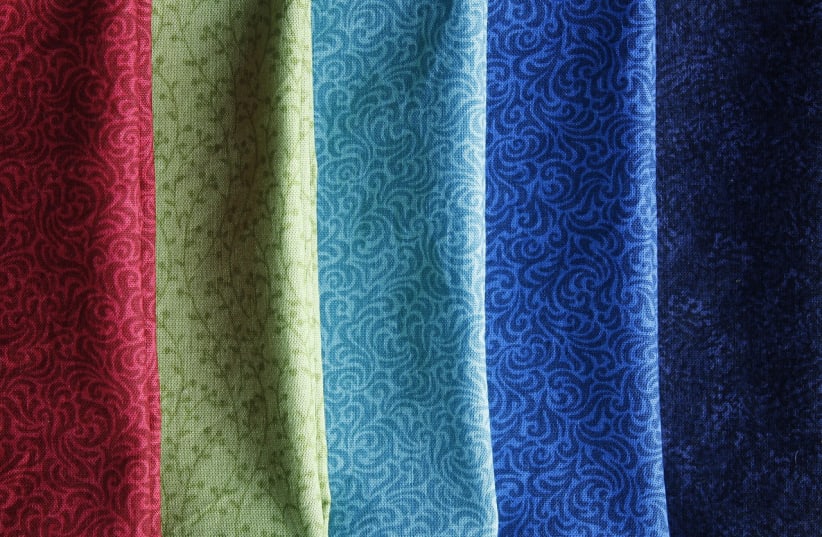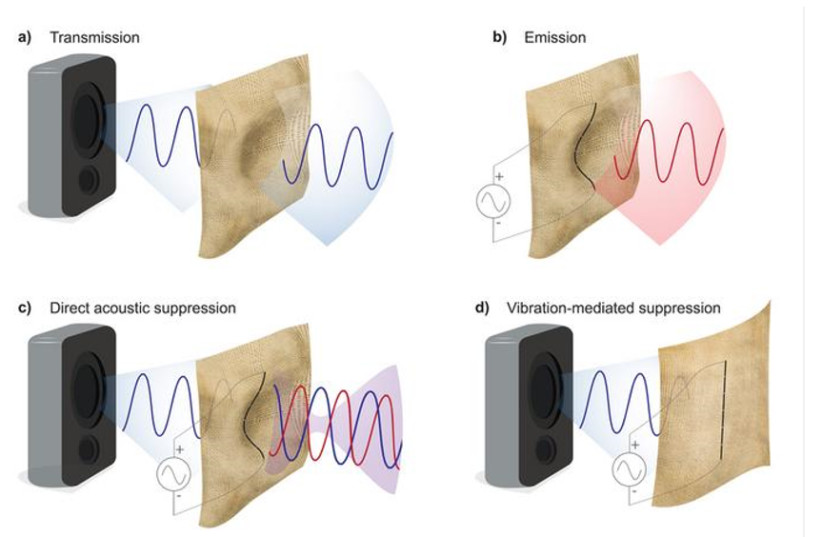The world is becoming increasingly noisy. From the hum of traffic outside your window to the next-door neighbor’s blaring TV to sounds from a co-worker’s cubicle, unwanted noise remains a resounding problem.
Whether intentionally generating acoustic waves or attempting to mitigate unwanted noise, sound control is an area of challenge and opportunity.
Active noise reduction involves suppression of sound in a small volume and has become a significant area of application for headphones and earbuds, where only a small quiet zone near the eardrum is needed. Larger-scale volumetric sound suppression, as in a room, is carried out mostly through passive approaches like reflecting sound using materials with high acoustic impedance or absorption of sound typically done with insulating fibrous structures or foams.
Can noise be muffled with a fabric barely thicker than a human hair? Researchers at the Massachusetts Institute of Technology (MIT) claim to have accomplished this amazing feat. An interdisciplinary collaboration of researchers from the famous institute and colleagues in other prominent American universities have developed a sound-suppressing silk fabric that could be used to create quiet spaces.
The secret is in the fibers
The fabric, contains a special fiber that vibrates when voltage is applied to it. The researchers leveraged those vibrations to suppress sound in two different ways. One is that the vibrating fabric generates sound waves that interfere with an unwanted noise to cancel it out, similar to noise-canceling headphones, which work well in a small space like your ears but do not work in large enclosures like rooms or planes.
The other, more surprising technique involves the holding still of the fabric to suppress vibrations that are key to the transmission of sound. This prevents noise from being transmitted through the fabric and quiets the volume beyond. This second approach allows for noise reduction in much larger spaces like rooms or cars.
By using common materials like silk, canvas, and muslin, the researchers created noise-suppressing fabrics that would be practical to implement in real-world spaces. For instance, one could use such a fabric to make dividers in open workspaces or thin fabric walls that prevent sound from getting through.
“Noise is a lot easier to create than quiet. In fact, to keep noise out we dedicate a lot of space to thick walls,” wrote the team. “We provide a new mechanism for creating quiet spaces with a thin sheet of fabric,” said materials science and engineering Prof. Yoel Fink who was senior author of the study.
The study’s lead author was Dr. Grace (Noel) Yang, and her team included MIT graduate students and chemical engineering Prof. Zachary Smith; graduate students at Case Western University in Cleveland, Ohio; Prof. Chu Ma of the University of Wisconsin at Madison; and a graduate student at the Rhode Island School of Design.
Their study has just appeared in the journal Advanced Materials under the title “Single Layer Silk and Cotton Woven Fabrics for Acoustic Emission and Active Sound Suppression.”
IN PREVIOUS RESEARCH, they sewed a single strand of piezoelectric fiber that produces an electrical signal when squeezed or bent into fabric. When a nearby noise causes the fabric to vibrate, the piezoelectric fiber converts those vibrations into an electrical signal that can capture the sound.
In their new study, the researchers turned the idea on its head to create a fabric loudspeaker that can be used to cancel out sound-waves. Applying an electrical signal to the piezoelectric fiber causes it to vibrate, which generates sound. The researchers demonstrated this by playing Bach’s Air using a 130-micrometer sheet of silk mounted on a circular frame.
“While we can use fabric to create sound, there is already so much noise in our world. We thought creating silence could be even more valuable,” Yang explained.
To enable direct sound suppression, the researchers use a silk fabric loudspeaker to emit sound waves that destructively interfere with unwanted sound waves. They control the vibrations of the piezoelectric fiber so that sound waves emitted by the fabric are the opposite of unwanted sound waves that strike the fabric, which can cancel out the noise – but this technique is effective only over a small area. So, the researchers built up this idea to develop a technique that uses fabric vibrations to suppress sound in much larger areas like a bedroom.
Suppose your next-door neighbors are watching a noisy sports program on TV in the middle of the night. You hear noise in your bedroom because the sound in their apartment causes your shared wall to vibrate, which forms sound waves on your side.
To suppress that sound, you could place the silk fabric onto your side of the shared wall, controlling the vibrations in the fiber to force the fabric to remain still. This vibration-mediated suppression prevents sound from being transmitted through the fabric. “If we can control those vibrations and stop them from happening, we can stop the noise that is generated, as well,” Yang added.
Surprisingly, the researchers found that holding the fabric still causes sound to be reflected by the fabric, resulting in a thin piece of silk that reflects sound like a mirror does with light.
Their experiments also revealed that both the mechanical properties of a fabric and the size of its pores affect the efficiency of sound generation. While silk and muslin have similar mechanical properties, the smaller pore sizes of silk make it a better fabric loudspeaker.
But the effective pore size also depends on the frequency of sound waves. If the frequency is low enough, even a fabric with relatively large pores could function effectively, Yang said.
When they tested the silk fabric in direct suppression mode, the researchers found that it could significantly reduce the volume of sounds up to 65 decibels (about as loud as enthusiastic human conversation). In vibration-mediated suppression mode, the fabric could reduce sound transmission up to 75%.
In the future, the team members want to explore the use of their fabric to block sound of multiple frequencies. This would likely require complex signal processing and additional electronics. They also aim at studying the architecture of the fabric to see how changing things like the number of piezoelectric fibers, the direction in which they are sewn, or the applied voltages could improve performance.
“There are a lot of knobs we can turn to make this sound-suppressing fabric really effective. We want to get people thinking about controlling structural vibrations to suppress sound. This is just the beginning,” Yang concluded.

